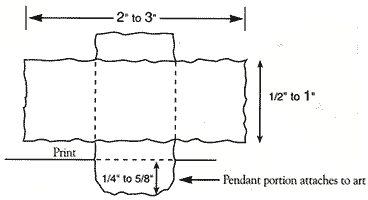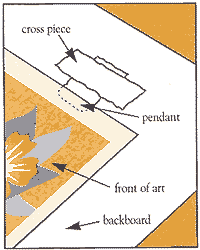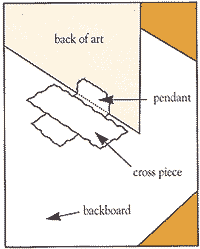|
|
| Line 51: |
Line 51: |
| | | | |
| | === Apply the Hinges === | | === Apply the Hinges === |
| | + | |
| | + | |
| | + | {| |
| | + | ! colspan=2 | Two Types - T-Hinge and V-Hinge |
| | + | ! |
| | + | |---- |
| | + | | [[Image:T-hinge.gif]] |
| | + | | [[Image:V-hinge.gif]] |
| | + | |---- |
| | + | ! T-Hinge |
| | + | ! V-Hinge |
| | + | |---- |
| | + | |align=center width=30% | Use when hinge can be hidden by the window mat. |
| | + | |align=center width=30% | Hinge is invisible allowing edges of art to show. |
| | + | |---- |
| | + | |} |
| | + | |
| | + | TIP: Use T-Hinges if possible. They are easier to make and the art gets gentle support on all sides from the window mat. |
| | + | |
| | + | === Adhering the Hinge to the Artwork === |
Revision as of 20:02, 4 November 2005
About This Information
The material and illustrations on this page are directly copied from the instructions in the "Lineco Museum Mounting Kit" with the consent of Lineco. We highly recommend this product which can be purchased at your local art shop or DickBlick.
We realized the need for this information and felt that Lineco, in addition to making great archival products, wrote a set of instructions that we could only be second best to. So with their permission, we reformatted their instructions for effective web presentation as shown here. We feel that this is the best way to mount fine artwork, but Expresso Beans cannot responsible for any adverse effects this information may have on the readers or their art work.
Museum Mounting Instructions
All you need to do conservation quality hinging of works of art.
- Wheat Starch Adhesive
- Japanese Hinding Paper
- Blotting Paper
- Mylar Separation Sheets
- Linen Tape for hinging window mat to the background
TIPS:
- Never cut or fold art to fit the frame.
- Use archival quality mat boards, not acidic mat.
- Don't wet or dry mount art. Never use cellophane or masking tape or nonarchival adhesives.
Make the Hinges
 Tear the paper for the hinges, tearing gives a "feathered" look and makes hinges less visible.
Tear the paper for the hinges, tearing gives a "feathered" look and makes hinges less visible.

TIPS:
- Use the smallest hinge which will support the art.
- Tearing paper: Drawing a water line with a small brush before tearing helps create a nice feathered edge.
Prepare the Adhesive
MICROWAVE COOKING:
* Tsp. dry wheat starch
* 6 Tsp. water (distilled, filter or deionized)
- Place 6 Tsp. of water in a container. Slowly add 1 Tsp. dry wheat starch and stir until it is completely mixed.
- Place the uncovered container off-center in the microwave. Cook at medium-high, stiring every 10 seconds.
- After 30-35 seconds the paste thickens and becomes translucent.
- Cover and let stand. The cool paste forms a semi-solid mass.
- Transfer amount needed to a second container by pressing through a fine strainer. Paste may become thinned for use. Dilute with water to a thin, cream-like consistency. Unused paste should be stored unrefrigerated in a cool, dark place. Discard when a sour smell is noticeable (2-5 days).
Quantities may be adjusted and will affect cooking times. The type of appliance and alititude will also affect cooking times.
Apply the Hinges
| Two Types - T-Hinge and V-Hinge
|
|

|

|
| T-Hinge
|
V-Hinge
|
| Use when hinge can be hidden by the window mat.
|
Hinge is invisible allowing edges of art to show.
|
TIP: Use T-Hinges if possible. They are easier to make and the art gets gentle support on all sides from the window mat.
Adhering the Hinge to the Artwork